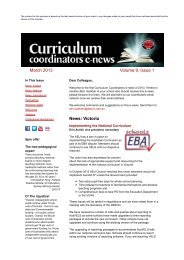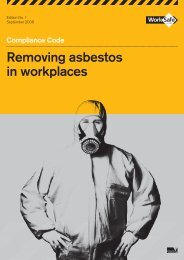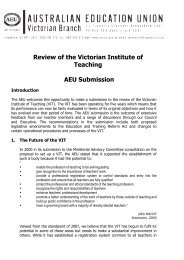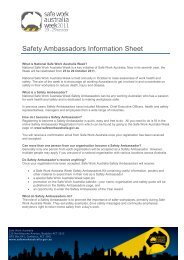Managing asbestos in workplaces - Compliance - WorkSafe Victoria
Managing asbestos in workplaces - Compliance - WorkSafe Victoria
Managing asbestos in workplaces - Compliance - WorkSafe Victoria
You also want an ePaper? Increase the reach of your titles
YUMPU automatically turns print PDFs into web optimized ePapers that Google loves.
Controll<strong>in</strong>g risks to health associated<br />
with the presence of <strong>asbestos</strong><br />
Case study: Enclos<strong>in</strong>g <strong>asbestos</strong> as a control measure<br />
A large dockside warehouse used for temporarily stor<strong>in</strong>g quantities of gra<strong>in</strong><br />
and stockfeed has walls made from a variety of materials <strong>in</strong>clud<strong>in</strong>g <strong>asbestos</strong><br />
cement (AC) sheet. Apart from the driver of a large front-end loader that is<br />
briefly driven <strong>in</strong>to the warehouse to load or unload the feed, there are no<br />
other employees who work <strong>in</strong> the warehouse. The person with management<br />
or control of the warehouse conducts the regular <strong>in</strong>spection of the AC sheet<br />
and identifies that it is <strong>in</strong> good condition. It is noted at the time that areas of<br />
previous m<strong>in</strong>or damage (broken sheets) have been repaired appropriately and<br />
that no risk to health exists currently. However, it is decided there is a chance<br />
that the sheets may be damaged aga<strong>in</strong> and if so, a risk to health may occur<br />
if fibres become airborne. Therefore the person with management or control<br />
decides to assess options for controll<strong>in</strong>g the risk.<br />
The most effective form of risk control <strong>in</strong> this case would be to remove the<br />
<strong>asbestos</strong>. But due to a range of issues – cost, warehouse downtime,<br />
productivity, the good condition of the AC sheet and the low risk it posed to<br />
health – the person with management or control decides not to remove the<br />
AC sheet but to enclose it to prevent future accidental damage.<br />
A solid false wall is constructed to enclose the AC sheet and bollards are<br />
erected <strong>in</strong> front of the new wall to prevent collisions that may occur when<br />
the front loader is operat<strong>in</strong>g <strong>in</strong>side the warehouse. The person with<br />
management or control must <strong>in</strong>clude the changes <strong>in</strong> the <strong>asbestos</strong> register<br />
and also cont<strong>in</strong>ue to monitor the condition of the AC sheet as well as the<br />
newly <strong>in</strong>stalled control measure.<br />
Reduc<strong>in</strong>g risk by seal<strong>in</strong>g the <strong>asbestos</strong><br />
126. If the <strong>asbestos</strong> has been enclosed so far as is reasonably practicable and<br />
a risk still rema<strong>in</strong>s, seal<strong>in</strong>g the ACM is the third control measure that must<br />
be implemented.<br />
127. Seal<strong>in</strong>g means cover<strong>in</strong>g the surface of the ACM with a protective coat<strong>in</strong>g<br />
to prevent the release of <strong>asbestos</strong> fibres <strong>in</strong>to the air. However, the task of<br />
seal<strong>in</strong>g the <strong>asbestos</strong> may present a risk to health for the person conduct<strong>in</strong>g<br />
the work if the <strong>asbestos</strong> is disturbed and fibres become airborne. Seal<strong>in</strong>g or<br />
pa<strong>in</strong>t<strong>in</strong>g should only be carried out on materials that are <strong>in</strong> good condition. If<br />
the material is significantly weathered, damaged or broken, the material should<br />
be removed and replaced with a material that does not conta<strong>in</strong> <strong>asbestos</strong>.<br />
128. Seal<strong>in</strong>g ACM is the least effective method for controll<strong>in</strong>g the release of<br />
<strong>asbestos</strong> fibres <strong>in</strong>to the air because the coat<strong>in</strong>g used is likely to deteriorate<br />
over time – especially if it is exposed to chemicals, extreme heat or cold, wet<br />
or dry conditions or physical impacts. Once it has deteriorated, the coat<strong>in</strong>g<br />
is also unlikely to provide any control. Therefore, seal<strong>in</strong>g ACM should only<br />
be considered an <strong>in</strong>terim control measure while a more effective control,<br />
such as remov<strong>in</strong>g or enclos<strong>in</strong>g the <strong>asbestos</strong>, can be implemented.<br />
30 <strong>Compliance</strong> code / <strong>Manag<strong>in</strong>g</strong> <strong>asbestos</strong> <strong>in</strong> <strong>workplaces</strong> <strong>WorkSafe</strong> <strong>Victoria</strong>

















